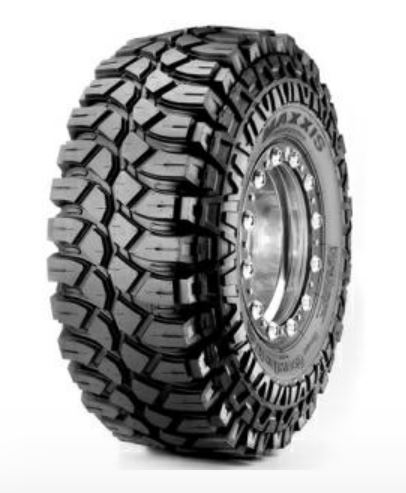TYRE M+S all terrain, 50/50 195/R15C, 103Q minimum
Valid Article
TYRE M+S all terrain, 50/50 195/R15C, 103Q minimum
Definition
General remarks
The choice of tyres is wider in most of the countries where we work than it is in Europe. The safety and reliability of a vehicle depend on the choice of tyres, which is complicated by the various kinds of terrain in which our vehicles work.
The dimensions and characteristics of tyres are specified by the vehicle manufacturer, taking into account the constraints of road-holding, load and speed.
Tyre markings
The designation of a tyre defines its specifications:
Example A: 7.50 R 16 C 8PR 112/110 N Tube Type
- 7.50 = Section width in inches
- R = Radial structure
- 16 = Inner diameter of tyre and of rim in inches
- C = Commercial vehicle or van tyre (reinforced)
- 8PR = Former structural strength rating (8 ply rating)
- 112 = Load index of tyre fitted singly, i.e. 1120 kg at 4.5 bars (2240 kg per axle)
- 110 = Load index of tyre fitted as one of a dual wheel set, i.e. 1060 kg at 4.5 bars (4240 kg per axle)
- N = Speed rating: maximum 140 km/h
- Tube Type = Fitted with inner tube
Example B: 235/85 R 16 C 114/111 N Tubeless
- 235 = Section width in mm
- /85 = Ratio of the sidewall height to the width of the tyre, expressed as a percentage
- R = Radial structure
- 16 = Inner diameter of tyre and of rim in inches
- C = Commercial vehicle or van tyre (reinforced)
- 114 = Load index of tyre fitted singly, i.e. 1180 kg at 4.75 bars (2360 per axle)
- 111 = Load index of tyre fitted as one of a dual wheel set, i.e. 1090 kg at 4.75 bars (4360 per axle)
- N = Speed rating: maximum 140 km/h
- Tubeless = Fitted without inner tube
Note: A section with of 7.50 inch corresponds with 235 mm. Therefore a tyre with designation 7.50R16 is interchangeable with one with 235/85R16.
Specifications
Tube type / tubeless
- A "tubeless" tyre must be fitted to a tubeless rim. If the rim is not tubeless, the tyre must be fitted with an inner tube.
- A "tube type" tyre must always be fitted with an inner tube, whatever the rim!
NB: It is strictly forbidden to fit a tube type tyre without inner tube!
Structure
Radial tyres, identified by the letter "R", are technically superior, but many countries still manufacture cross-ply tyres. These should be avoided since they are less safe and are inadequate for the conditions of use and characteristics of MSF vehicles.
If the letter "R" or the word "Radial" does not appear on the side of the tyre, it is not a radial tyre.
PR = Ply rating
Load index, combined with the speed index (identified by a figure, followed by the letters PR).
Load index
Indicates the load for which a tyre was designed.
When two load indices follow each other, the first is the load index for the tyre when fitted to a single wheel, and the second is the load index for the tyre when fitted to one wheel of a dual wheel set.
Example: 104/102
- 104 = 900 kg (single wheel)
- 102 = 850 kg (dual wheels)
Speed rating
Indicate the speed for which a tyre was designed.
Example: N = maximum speed of 140 km/h
CAUTION: The speed rating specified by the vehicle manufacturer must always be followed (see the vehicle instruction manual).
Tyre pressure
Tyre pressures are legally specified by vehicle and tyre manufacturers to ensure maximum safety. It is essential to observe these pressures both to achieve optimum tyre lifespan and for the sake of your own safety. Tyre pressure may sometimes need to be adjusted to take account of driving conditions.
Tyre pressure should be checked regularly (every week).
To find out the optimum pressure, see the vehicle instruction manual (or consult your technical department).
Instructions for use
Precautions for Use
- The more heavily loaded the vehicle is and the higher the speed attained, the higher the tyre pressure must be.
- It is essential to rebalance the wheels after changing tyres.
- An unbalanced wheel can cause damage to certain steering components (track rod ends, bearings etc.).
Tyre treads and tread profiles
The choice of tyre tread (i.e. the shape and depth of the treads) will depend on the terrain and driving conditions.
All-terrain type
- Tarmac/asphalt: tyre with road treads, durable even at high temperatures due to the density of the rubber.
- Dirt: tyre of intermediate design, with deeper and more open treads for better water expulsion and grip.
Heavy-duty type
Tyre with road/rock tread, designed for pick-ups with heavy payload (maximum load = 900 kg).
Mud type
Tyre with deep treads and narrow tread profile for better mud expulsion.
Advice on ordering
For non-standard vehicles, the following information should be provided to supply centres or technical departments:
For vans
- standard designation
- type of vehicle
- type of terrain
For heavy goods vehicles
- standard designation
- type of vehicle
- Total Weight Allowance (TWA)
- single or dual wheel fitting
- type of terrain

